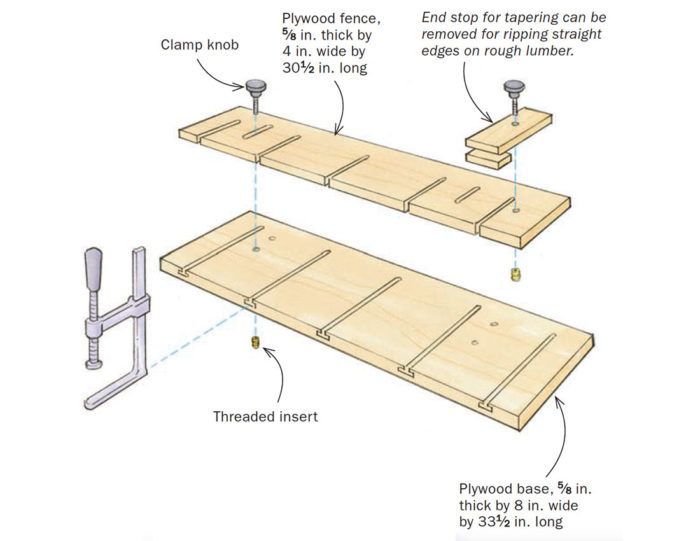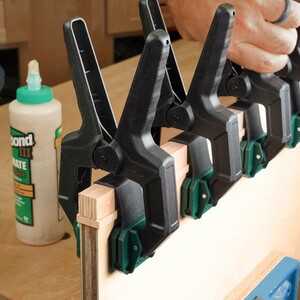
I see lots of router jigs that use toggle clamps, which are outdated in my opinion. Routing T-slots in your jigs lets you make use of track clamps instead. They are designed for today’s assembly tables and guide rails. A model made by Bessey sells for $20 at Home Depot.
Also called guide-rail clamps, these have a number of critical advantages over toggles. First, track clamps adjust quickly, sliding up and down to accommodate workpiece thickness, and back and forth in their slots for overall positioning. Second, because of the C-shaped design, the clamp itself absorbs all of the clamping pressure, which means your jigs can be thinner and lighter in many cases.
 |
 |
My tapering jig showcases many of the advantages of track clamps. It has routed T-slots for the clamps and a movable fence for various tapers, plus a detachable stop block. Long enough for most table legs, it handles all widths and thicknesses. It’s also great for sawing straight edges on rough-sawn lumber. I slide the jig against the rip fence, but you could easily attach a miter-slot runner to the bottom.
I use track clamps on most of the other jigs I build too, including my tablesaw crosscut sled.
 |
 |
Depending on the jig, I’ll either rout T-slots through the plywood, using two straight bits, or only partly into the panel, using a straight router bit to clear out waste and a large keyhole-style bit: the Axcaliber T-Slot Cutter for Track Clamps, from Axminster, UK. This bit cuts a groove 1/2 in. wide by 1/4 in. deep. For durability, I recommend leaving at least 3/16 in. of material above the wide slots.
—OLA CARMONIUS, Malmö, Sweden
Illustrations by Dan Thornton
From Fine Woodworking issue #279
Fine Woodworking Recommended Products

Double Sided Tape

Hedgehog featherboards

Incra Miter 1000HD





















Comments
The diagrams seem to show that the width of the narrow slots is the same in the base and the fence board, which is a bit confusing because, unless i wrong, that would make it impossible to turn the fence board in relation to the base. Correct me if im wrong.
Correct observation. The slots in the fence are much wider in real life than shown in the illustration. Around 16mm while the narrow slots are 8mm. This allows for quite much angle of the fence.
Thanks Ola for raising this idea.
It's surprisingly not very popular, despite Microjig pushing its similar Matchfit system.
For those using the metric system (my router has a 8 mm shank, and is not compatible with the 1/2" Axminster bit you mentioned), it's worth mentioning that :
- actually every M8 T-Slot bit is OK for rail clamps (CMT, Fraiser, ENT, etc.).
- M8 nuts, hexagonal or square, also fit, that's handy for stop blocks for example (and for stop blocks in thinner plywood, you can use a M6 T-Slot bit)
Here is a picture of my CMT bits, for the precise dimensions in millimeter.
Good with some additional info about suitable router bits.
I agree it's extremely strange this idea haven't got wider spread. In most jigs I only see advantages by using this clamping concept but still the world seems very slow to adopt.
I purchased a couple of Microjig clamps and their special router bit. Seems like a great solution for many clamping applications.
My first attempt was cutting 3 dovetail grooves in a 3/4 inch MDF base for a table saw sled. The MDF warped in the area where the grooves were cut. Not a lot of warp but enough to throw off the accuracy of a precise sled. One reason I use MDF instead of plywood for sleds is that MDF is very stable. Tried clamping the MDF to take out the warp, but some remains. Wondering if anyone else has run into this problem.
Hi all,
I have done two small things to be used with those wooden t-track.
It's in french, but pictures are pretty clear :
- A very simple (and effective) clamp : https://www.lairdubois.fr/creations/16867-une-butee-qui-serre-et-qui-plaque-en-trois-coups-de-scie.html
- A stop block to be used in the same track than the track clamp :
https://www.lairdubois.fr/creations/16264-butee-pour-rail-en-t.html
Thanks. The links provide me with some ideas for an assembly table I am building
Log in or create an account to post a comment.
Sign up Log in